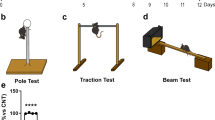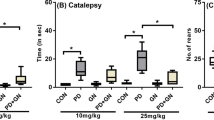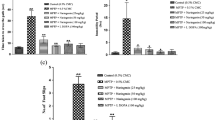Abstract
Our aim was to investigate whether tangeretin, a citrus flavonoid, was able to prevent neuroinflammation and improve dementia in 1-methyl-4-phenyl-1,2,3,6-tetrahydropyridine (MPTP)-induced rodent model of Parkinson’s disease (PD). MPTP-HCl was infused into the substantia nigra pars compacta of male Sprague–Dawley rats. Tangeretin (50, 100 or 200 mg/kg body weight) was administered orally starting 3 days prior to MPTP injection and was continued for 20 days following injection. MPTP-lesioned rats revealed motor dysfunction in bar test and rota rod tests. Deficits in working memory and object recognition function were also observed following MPTP induction. Tangeretin treatment significantly attenuated the memory deficits and improved motor functions and cognition. Immunohistochemical analysis reveals the protective effects of tangeretin against MPTP lesion-induced dopaminergic degeneration and hippocampal neuronal loss. Tangeretin reduced expression of inflammatory mediators—COX-2, iNOS—as well reduced the levels of cytokines—interleukins (IL)—IL-1β, IL-6 and IL-2. The experimental data suggest tangeretin as an effective candidate drug with potential for prevention and treatment of neuroinflammation and dementia associated with PD.







Similar content being viewed by others
References
Barcia C, Sanchez Bahillo A, Fernandez-Villalba E, Bautista V, Poza YPM, Fernandez-Barreiro A, Hirsch EC, Herrero MT (2004) Evidence of active microglia in substantia nigra pars compacta of parkinsonian monkeys 1 year after MPTP exposure. Glia 46:402–409
Barnes J, Boubert L, Harris J, Lee A, David AS (2003) Reality monitoring and visual hallucinations in Parkinson’s disease. Neuropsychologia 41:e565–e574
Benavente-García O, Castillo J (2008) Update on uses and properties of citrus flavonoids: new findings in anticancer, cardiovascular, and anti-inflammatory activity. J Agric Food Chem 56:6185–6205
Bezzi P, Domercq M, Brambilla L, Galli R, Schols D, De Clercq E, Vescovi A, Bagetta G, Kollias G, Meldolesi J, Volterra A (2001) CXCR4-activated astrocyte glutamate release via TNFalpha: amplification by microglia triggers neurotoxicity. Nat Neurosci 4:702–710
Blandini F, Nappi G, Tassorelli C, Martignoni E (2000) Functional changes of the basal ganglia circuitry in Parkinson’s disease. Prog Neurobiol 62:63–88
Braak H, Rub U, Jansen Steur EN, Del Tredici K, de Vos RA (2005) Cognitive status correlates with neuropathologic stage in Parkinson disease. Neurology 64:e1404–e1410
Braga R, Kouzmine I, Canteras NS, Da Cunha C (2005) Lesion of the substantia nigra, pars compacta impairs delayed alternation in a Y-maze in rats. Exp Neurol 192:134–141
Capitelli C, Sereniki A, Lima MM, Reksidler AB, Tufik S, Vital MA (2008) Melatonin attenuates tyrosine hydroxylase loss and hypolocomotion in MPTP-lesioned rats. Eur J Pharmacol 594:101–108
Centonze D, Gubellini P, Rossi S, Picconi B, Pisani A, Bernardi G, Calabresi P, Baunez C (2005) Subthalamic nucleus lesion reverses motor abnormalities and striatal glutamatergic over activity in experimental parkinsonism. Neuroscience 133:831–840
Cepeda C, Levine MS (1998) Dopamine and N-methyl-d-aspartate receptor interactions in the neostriatum. Dev Neurosci 20:1–18
Chihab R, Oillet J, Bossenmeyer C, Daval JL (1998) Glutamate triggers cell death specifically in mature central neurons through a necrotic process. Mol Genet Metab 63:142–147
Crucian GP, Okun MS (2003) Visual-spatial ability in Parkinson’s disease. Front Biosci 8:s992–s997
Da Cunha C, Gevaerd MS, Vital MA, Miyoshi E, Andreatini R, Silveira R, Takahashi RN, Canteras NS (2001) Memory disruption in rats with nigral lesions induced by MPTP: a model for early Parkinson’s disease amnesia. Behav Brain Res 124:9–18
Datla KP, Christidou M, Widmer WW, Rooprai HK, Dexter DT (2001) Tissue distribution and neuroprotective effects of citrus flavonoid tangeretin in a rat model of Parkinson’s disease. NeuroReport 12:3871–3875
Emre M (2003) Dementia associated with Parkinson’s disease. Lancet Neurol 2:229–237
Ennaceur A, Delacour J (1988) A new one-trial test for neurobiological studies of memory in rats. I. Behavioral data. Behav Brain Res 31:47–59
Ferro MM, Bellissimo MI, Anselmo-Franci JA, Angellucci ME, Canteras NS, Da Cunha C (2005) Comparison of bilaterally 6-OHDA- and MPTP-lesioned rats as models of the early phase of Parkinson’s disease: histological, neurochemical, motor and memory alterations. J Neurosci Meth 148:78–87
Funaro A, Wu X, Song M, Zheng J, Guo S, Rakariyatham K, Rodriguez-Estrada MT, Xiao H (2016) Enhanced anti-inflammatory activities by the combination of luteolin and tangeretin. J Food Sci 81:H1320–H1327
Gevaerd MS, Takahashi RN, Silveira R, Da Cunha C (2001) Caffeine reverses the memory disruption induced by intra-nigral MPTP-injection in rats. Brain Res Bull 55:101–106
Gilbert PE, Kesner RP (2006) The role of the dorsal CA3 hippocampal subregion in spatial working memory and pattern separation. Behav Brain Res 169:142–149
Girotti F, Soliveri P, Carella F, Piccolo I, Caffarra P, Musicco M, Caraceni T (1988) Dementia and cognitive impairment in Parkinson’s disease. J Neurol Neurosurg Psychiatry 51:1498–1502
Hannesson DK, Howland JG, Phillips AG (2004) Interaction between perirhinal and medial prefrontal cortex is required for temporal order but not recognition memory for objects in rats. J Neurosci 24:4596–4604
Hirohata M, Ono K, Morinaga A, Yamada M (2008) Non-steroidal anti-inflammatory drugs have potent anti-fibrillogenic and fibril-destabilizing effects for alpha-synuclein fibrils in vitro. Neuropharmacology 54:620–627
Hirsch EC, Hunot S, Hartmann A (2005) Neuroinflammatory processes in Parkinson’s disease. Parkinsonism Relat Disord 11:S9–S15
Hirsch EC, Vyas S, Hunot S (2012) Neuroinflammation in Parkinson’s disease. Parkinsonism Relat Disord 18:S210–S212
Ho SC, Kuo CT (2014) Hesperidin, nobiletin, and tangeretin are collectively responsible for the anti-neuroinflammatory capacity of tangerine peel (Citri reticulatae pericarpium). Food Chem Toxicol 71:176–182
Ho YJ, Chang YC, Liu TM, Tai MY, Wong CS, Tsai YF (2000) Striatal glutamate release during novelty exposure-induced hyperactivity in olfactory bulbectomized rats. Neurosci Lett 287:117–120
Ho YJ, Ho SC, Pawlak CR, Yeh KY (2011) Effects of d-cycloserine on MPTP-induced behavioral and neurological changes: potential for treatment of Parkinson’s disease dementia. Behav Brain Res 219:280–290
Ho SC, Hsu CC, Pawlak CR, Tikhonova MA, Lai TJ, Amstislavskaya TG, Ho YJ (2014) Effects of ceftriaxone on the behavioral and neuronal changes in an MPTP-induced Parkinson’s disease rat model. Behav Brain Res 268:177–184
Hota SK, Barhwal K, Ray K, Singh SB, Ilavazhagan G (2008) Ceftriaxone rescues hippocampal neurons from excitotoxicity and enhances memory retrieval in chronic hypobaric hypoxia. Neurobiol Learn Mem 89:522–532
Hsieh MH, Gu SL, Ho SC, Pawlak CR, Lin CL, Ho YJ, Lai TJ, Wu FY (2012a) Effects of MK-801 on recognition and neurodegeneration in an MPTP-induced Parkinson’s rat model. Behav Brain Res 229:41–47
Hsieh MH, Ho SC, Yeh KY, Pawlak CR, Chang HM, Ho YJ, Lai TJ, Wu FY (2012b) Blockade of metabotropic glutamate receptors inhibits cognition and neurodegenerationin an MPTP-induced Parkinson’s disease rat model. Pharmacol Biochem Behav 102:64–71
Hsu CY, Hung CS, Chang HM, Liao WC, Ho SC, Ho YJ (2015) Ceftriaxone prevents and reverses behavioral and neuronal deficits in an MPTP-induced animal model of Parkinson’s disease dementia. Neuropharmacology 91:43–56
Hunsaker MR, Lee B, Kesner RP (2008) Evaluating the temporal context of episodic memory: the role of CA3 and CA1. Behav Brain Res 188:310–315
Imamura K, Hishikawa N, Sawada M, Nagatsu T, Yoshida M, Hashizume Y (2003) Distribution of major histocompatibility complex class II-positive microglia and cytokine profile of Parkinson’s disease brains. Acta Neuropathol 106:518–526
Imamura K, Hishikawa N, Ono K, Suzuki H, Sawada M, Nagatsu T, Yoshida M, Hashizume Y (2005) Cytokine production of activated microglia and decrease in neurotrophic factors of neurons in the hippocampus of Lewy body disease brains. Acta Neuropathol 109:141–150
Jin M, Kim BW, Koppula S, Kim IS, Park JH, Kumar H, Choi DK (2012) Molecular effects of activated BV-2 microglia by mitochondrial toxin 1-methyl- 4-phenylpyridinium. Neurotoxicology 33:147–155
Kim SY, Jones TA (2013) The effects of ceftriaxone on skill learning and motor functional outcome after ischemic cortical damage in rats. Restor Neurol Neurosci 31:87–97
Klegeris A, McGeer PL (2005) Non-steroidal anti-inflammatory drugs (NSAIDs) and other anti-inflammatory agents in the treatment of neurodegenerative disease. Curr Alzheimer Res 2:355–365
Kohutnicka M, Lewandowska E, Kurkowska-Jastrzebska I, Czlonkowski A, Czlonkowska A (1998) Microglial and astrocytic involvement in a murine model of Parkinson’s disease induced by 1-methyl-4-phenyl-1,2,3,6- tetrahydropyridine (MPTP). Immunopharmacology 39:167–180
Langston JW, Forno LS, Tetrud J, Reeves AG, Kaplan JA, Karluk D (1999) Evidence of active nerve cell degeneration in the substantia nigra of humans years after 1-methyl-4-phenyl-1, 2, 3, 6-tetrahydropyridine exposure. Ann Neurol 46:598–605
Lee YY, Lee EJ, Park JS, Jang SE, Kim DH, Kim HS (2016) Anti-inflammatory and antioxidant mechanism of tangeretin in activated microglia. J Neuroimmune Pharmacol 11:294–305
Li JS, Chao YS (2008) Electrolytic lesions of dorsal CA3 impair episodic-like memory in rats. Neurobiol Learn Mem 89:192–198
Li Y, Liu C, Zhao Y, Hu K, Zhang J, Zeng M, Luo T, Jiang W, Wang H (2013) Sevoflurane induces short term changes in proteins in the cerebral cortices of developing rats. Acta Anaesthesiol Scand 57:380–390
Luetjens CM, Bui NT, Sengpiel B, Munstermann G, Poppe M, Krohn AJ, Bauerbach E, Krieglstein J, Prehn JH (2000) Delayed mitochondrial dysfunction in excitotoxic neuron death: cytochrome c release and a secondary increase in superoxide production. J Neurosci 20:5715–5723
Ma LL, Wang DW, Yu XD, Zhou YL (2016) Tangeretin induces cell cycle arrest and apoptosis through upregulation of PTEN expression in glioma cells. Biomed Pharmacother 81:491–496
McAllister CG, van Kammen DP, Rehn TJ, Miller AL, Gurklis J, Kelley ME, Yao J, Peyers JL (1995) Increases in CSF levels of interleukin-2 in schizophrenia: effects of recurrence of psychosis and medication status. Am J Psychiatry 152:1291–1297
McGeer PL, McGeer EG (2004) Inflammation and neurodegeneration in Parkinson’s disease. Parkinsonism Relat Disord 10:S3–S7
Meshul CK, Emre N, Nakamura CM, Allen C, Donohue MK, Buckman JF (1999) Time-dependent changes in striatal glutamate synapses following a 6-hydroxydopamine lesion. Neuroscience 88:1–16
Mogi M, Togari A, Ogawa M, Ikeguchi K, Shizuma N, Fan D, Nakano I, Nagatsu T (1998) Effects of repeated systemic administration of 1-methyl-4-phenyl-1,2,3,6- tetrahydropyridine (MPTP) to mice on interleukin-1beta and nerve growth factor in the striatum. Neurosci Lett 250:25–28
More SV, Kumar H, Kim IS, Song SY, Choi DK (2013) Cellular and molecular mediators of neuroinflammation in the pathogenesis of Parkinson’s disease. Mediators Inflamm 2013:952375
Mosley RL, Benner EJ, Kadiu I, Thomas M, Boska MD, Hasan K, Laurie C, Gendelman HE (2006) Neuroinflammation, oxidative stress and the pathogenesis of Parkinson’s disease. Clin Neurosci Res 6:261–281
Moss DW, Bates TE (2001) Activation of murine microglial cell lines by lipopolysaccharide and interferon-gamma causes NO-mediated decreases in mitochondrial and cellular function. Eur J Neurosci 13:529–538
Mumby DG, Tremblay A, Lecluse V, Lehmann H (2005) Hippocampal damage and anterograde object-recognition in rats after long retention intervals. Hippocampus 15:1050–1056
Nagatsu T, Mogi M, Ichinose H, Togari A (2000) Cytokines in Parkinson’s disease. J Neural Transm Suppl 58:143-151
Nolan YM, Sullivan AM, Toulouse A (2013) Parkinson’s disease in the nuclear age of neuroinflammation. Trends Mol Med 19:187–196
Ojha S, Javed H, Azimullah S, Abul Khair SB, Haque ME (2016) Glycyrrhizic acid attenuates neuroinflammation and oxidative stress in rotenone model of Parkinson’s disease. Neurotox Res 29:275–287
Owen AM, Sahakian BJ, Hodges JR, Summers BA, Polkey CE, Robbins TW (1995) Dopamine dependent frontostriatal planning deficits in early Parkinson’s disease. Neuropsychology 9:126–140
Paxinos G, Watson C (1986) The rat brain in stereotaxic coordinates. Academic Press, London
Periyasamy K, Baskaran K, Ilakkia A, Vanitha K, Selvaraj S, Sakthisekaran D (2015) Antitumor efficacy of tangeretin by targeting the oxidative stress mediated on 7,12-dimethylbenz(a) anthracene-induced proliferative breast cancer in Sprague-Dawley rats. Cancer Chemother Pharmacol 75:263–272
Perry JC, Hipolide DC, Tufik S, Martins RD, Da Cunha C, Andreatini R, Vital MA (2005) Intra-nigral MPTP lesion in rats: behavioral and autoradiography studies. Exp Neurol 195:322–329
Perry VH, Nicoll JA, Holmes C (2010) Microgliain neurodegenerative disease. Nat Rev Neurol 6:193–201
Petitto JM, McNamara RK, Gendreau PL, Huang Z, Jackson AJ (1999) Impaired learning and memory and altered hippocampal neurodevelopment resulting from interleukin-2 gene deletion. J Neurosci Res 56:441–446
Piekema C, Kessels RP, Mars RB, Petersson KM, Fernandez G (2006) The right hippocampus participates in short-term memory maintenance of object-location associations. Neuroimage 33:374–382
Plaitakis A, Shashidharan P (2000) Glutamate transport and metabolism in dopaminergic neurons of substantia nigra: implications for the pathogenesis of Parkinson’s disease. J Neurol 247:II25–II35
Ramirez-Ruiz B, Junque C, Marti MJ, Valldeoriola F, Tolosa E (2006) Neuropsychological deficits in Parkinson’s disease patients with visual hallucinations. Mov Disord 21:e1483–e1487
Rossetti ZL, Carboni S (2005) Noradrenaline and dopamine elevations in the rat prefrontal cortex in spatial working memory. J Neurosci 25:2322–2329
Sanberg PR, Bunsey MD, Giordano M, Norman AB (1988) The catalepsy test: its ups and downs. Behav Neurosci 102:748–759
Schneider JS, Tinker JP, VanVelson M, Giardiniere M (2000) Effects of the partial glycine agonist d-cycloserine on cognitive functioning in chronic low dose MPTP-treated monkeys. Brain Res 860:190–194
Sherer TB, Betarbet R, Kim JH, Greenamyre JT (2003) Selective microglial activation in the rat rotenone model of Parkinson’s disease. Neurosci Lett 341:87–90
Smeyne M, Jiao Y, Shepherd KR, Smeyne RJ (2005) Glia cell number modulates sensitivity to MPTP in mice. Glia 52:144–152
Sriram K, Matheson JM, Benkovic SA, Miller DB, Luster MI, O’Callaghan JP (2006) Deficiency of TNF receptors suppresses microglial activation and alters the susceptibility of brain regions to MPTP-induced neurotoxicity: role of TNF-alpha. FASEB J 20:670–682
Stanic D, Finkelstein DI, Bourke DW, Drago J, Horne MK (2003) Time course of striatal reinnervation following lesions of dopaminergic SNpc neurons of the rat. Eur J Neurosci 18:1175–1188
Swennes AG, Alworth LC, Harvey SB, Jones CA, King CS, Crowell-Davis SL (2011) Human handling promotes compliant behavior in adult laboratory rabbits. J Am Assoc Lab Anim Sci 50:41–45
Sy HN, Wu SL, Wang WF, Chen CH, Huang YT, Liou YM, Chiou CS, Pawlak CR, Ho YJ (2010) MPTP-induced dopaminergic degeneration and deficits in object recognition in rats are accompanied by neuroinflammation in the hippocampus. Pharmacol Biochem Behav 95:158–165
Voss J, Sanchez C, Michelsen S, Ebert B (2003) Rotarod studies in the rat of the GABAA receptor agonist gaboxadol: lack of ethanol potentiation and benzodiazepine cross-tolerance. Eur J Pharmacol 482:215–222
Vuckovic MG, Wood RI, Holschneider DP, Abernathy A, Togasaki DM, Smith A, Petzinger GM, Jakowec MW (2008) Memory, mood, dopamine, and serotonin in the 1-methyl-4-phenyl-1,2,3,6-tetrahydropyridine-lesioned mouse model of basal ganglia injury. Neurobiol Dis 32:e319–e327
Wada M, Yoshimi K, Higo N, Ren YR, Mochizuki H, Mizuno Y, Kitazawa S (2006) Statistical parametric mapping of immunopositive cell density. Neurosci Res 56:96–102
Wang WF, Wu SL, Liou YM, Wang AL, Pawlak CR, Ho YJ (2009) MPTP lesion causes neuroinflammation and deficits in object recognition in Wistar rats. Behav Neurosci 123:1261–1270
Wang AL, Liou YM, Pawlak CR, Ho YJ (2010) Involvement of NMDA receptors in both MPTP-induced neuroinflammation and deficits in episodic-like memory in Wistar rats. Behav Brain Res 208:38–46
Whitton PS (2007) Inflammation as a causative factor in the aetiology of Parkinson’s disease. Br J Pharmacol 150:963–976
Wilms H, Rosenstiel P, Sievers J, Deuschl G, Zecca L, Lucius R (2003) Activation of microglia by human neuromelanin is NF-kappa B dependent and involves p38 mitogen-activated protein kinase: implications for Parkinson’s disease. FASEB J 17:500–502
Wu JJ, Cui Y, Yang YS, Jung SC, Hyun JW, Maeng YH, Park DB, Lee SR, Kim SJ, Eun SY (2013) Mild mitochondrial depolarization is involved in a neuroprotective mechanism of Citrus sunki peel extract. Phytother Res 27:564–571
Xiong N, Huang J, Chen C, Zhao Y, Zhang Z, Jia M, Zhang Z, Hou L, Yang H, Cao X, Liang Z, Zhang Y, Sun S, Lin Z, Wang T (2012) Dl-3-n-butylphthalide, a natural antioxidant, protects dopamine neurons in rotenone models for Parkinson’s disease. Neurobiol Aging 33:1777–1791
Yasuda Y, Shimoda T, Uno K, Tateishi N, Furuya S, Yagi K, Suzuki K, Fujita S (2008) The effects of MPTP on the activation of microglia/astrocytes and cytokine/chemokine levels in different mice strains. J Neuroimmunol 204:43–51
Zhang WN, Pothuizen HH, Feldon J, Rawlins JN (2004) Dissociation of function within the hippocampus: effects of dorsal, ventral and complete excitotoxic hippocampal lesions on spatial navigation. Neuroscience 127:289–300
Author information
Authors and Affiliations
Corresponding author
Ethics declarations
Conflict of interest
We authors declare that we do not have any conflicts of interest.
Rights and permissions
About this article
Cite this article
Yang, Js., Wu, Xh., Yu, Hg. et al. Tangeretin inhibits neurodegeneration and attenuates inflammatory responses and behavioural deficits in 1-methyl-4-phenyl-1,2,3,6-tetrahydropyridine (MPTP)-induced Parkinson’s disease dementia in rats. Inflammopharmacol 25, 471–484 (2017). https://doi.org/10.1007/s10787-017-0348-x
Received:
Accepted:
Published:
Issue Date:
DOI: https://doi.org/10.1007/s10787-017-0348-x




